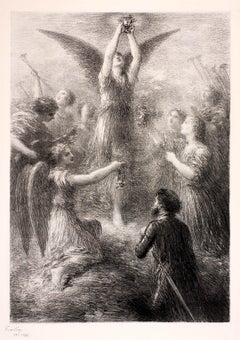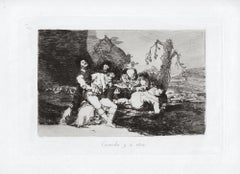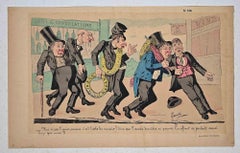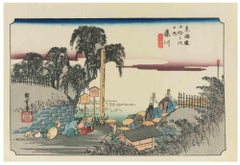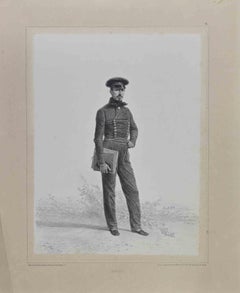19th Century Figurative Prints
to
1,322
6,367
1,068
177
49
38
Overall Width
to
Overall Height
to
5,535
347
111
56
35
25
17
6
2
267
122
110
109
101
3,649
7,713
24,787
6,797
288
596
1,431
1,215
1,236
2,085
2,940
5,174
2,854
1,425
3,109
4,509
3,146
42
5,336
2,699
2,110
1,798
1,549
1,067
864
589
559
515
506
503
437
295
248
240
226
220
215
202
4,425
2,148
702
674
436
335
5,753
4,235
765
Period: 19th Century
Prelude de Lohengrin (2e planche) (The Appearance of the Holy Grail)
Located in Fairlawn, OH
Prelude de Lohengrin (2e planche) (The appearance of the Holy Grail)
Lithograph, 1898
Signed and dated in the stone lower left (see photo)
Printed on chine collee paper
Condition...
Category
Romantic 19th Century Figurative Prints
Materials
Lithograph
Curarlos y a Otra - Etching by Francisco Goya - 1863
Located in Roma, IT
Curarlos y a otra is an original artwork realized by the great Spanish artist Francisco Goya in 1810. Original etching on paper.
The artwork belongs to the famous print collection L...
Category
Old Masters 19th Century Figurative Prints
Materials
Etching, Aquatint
Drunkards - Original Lithograph - 1880
Located in Roma, IT
Drunkards is an original Modern Artwork realized in 1880.
Original Lithograph on paper.
The work is part of a satirical series.
Printed by Imprimerie Robert, Paris.
Passepartout...
Category
Modern 19th Century Figurative Prints
Materials
Lithograph
Fujikawa - Woodcut by Utagawa Kunisada - 1832
Located in Roma, IT
Fujikawa is a woodcut print realized by Utagawa Hiroshige in 1833.
It is part of the suite "The Fifty-three Stations of Tokaido".
Very good condition.
Category
Modern 19th Century Figurative Prints
Materials
Woodcut
Kabuki Scene - Woodblock Print by Utagawa Kunisada - Mid-19th Century
Located in Roma, IT
Kabuki Scene is an original Woodcut print realized in mid 19 century by Utagawa Kunisada.
Good condition and Beautiful colored woodblock print.
This wonderful modern artwork repr...
Category
Modern 19th Century Figurative Prints
Materials
Woodcut
Portrait - Lithograph by Auguste Raffet - 1843
Located in Roma, IT
Portrait is a Lithograph realized by Auguste Raffet (1804-1860).
Good condition on a yellowed paper.
Hand signed and dated by the artist on the lower right corner.
Denis Auguste M...
Category
Modern 19th Century Figurative Prints
Materials
Lithograph
Dios la Perdone: Y era su Madre - Etching by Francisco Goya - 1881
Located in Roma, IT
Dios la perdone: Y era su madre is a black and White aquatint, drypoint, and etching printed in blue-black ink on laid paper from Caprichos realized after Francisco Goya in 1881-188...
Category
Modern 19th Century Figurative Prints
Materials
Etching
Direccion de Hidrografia... - Etching by Tomàs Gozàlez - 1802
Located in Roma, IT
Etching on paper realized, among the others, by Tomàs Gozàlez.
From Juan Corradi, Descubrimiento y conquista de la América o Compendio de la historia general del Nuevo Mundo, Madrid...
Category
Modern 19th Century Figurative Prints
Materials
Etching
Todos Caeran - Etching by Francisco Goya - 1881
Located in Roma, IT
Todos Caeran is a black and White aquatint, drypoint, and etching printed in blue-black ink on laid paper from Caprichos realized after Francisco Goya in 1881-1886.
6th Edition.
T...
Category
Modern 19th Century Figurative Prints
Materials
Etching
Gibbon Falls, Yellow-Stone National Park
Located in Paonia, CO
Gibbon Falls, Yellow-Stone National Park is a chromolithograph from c.1880 showing two fisherman at the base of Gibbon Falls. This chromolithograph is a dramatic view of the powerful Gibbon waterfall that cascades 84 feet into a small, clear pool. The setting is quintessential Yellowstone, with scrubby pine trees and rocky cliffs. The inscription on the bottom left corner below the image says Scenery From Nature on the Northern Pacific R.R. Established by the U.S. Congress and signed into law by President Ulysses S. Grant on March 1, 1872 Yellowstone was the first national park in the U.S. and is widely held to be the first national park in the world. Native Americans have lived in the Yellowstone region for at least 11,000 years. The Northern Pacific Railroad...
Category
Naturalistic 19th Century Figurative Prints
Materials
Lithograph
Rescue at Sea during the Storm - Original etching
By Pierre Emile Berthelemy
Located in Paris, IDF
Pierre-Emile BERTHELEMY (1818 - 1894)
Rescue at Sea during the Storm
Original etching
Printed signature in the plate
On linen vellum 24 x 33 cm (c. 10 x 13 in)
Excellent condition
Category
Realist 19th Century Figurative Prints
Materials
Etching
Ann Moore - The fasting woman of Tutbury
Located in Bournemouth, Dorset
Ann Moore, the fasting woman of Tutbury, born 1761. Went on long fasts for money from 1807, but exposed as a fraud in 1813. Later sent to prison for falsely collecting money for char...
Category
19th Century Figurative Prints
Materials
Engraving
$102 Sale Price
20% Off
Incandescence - Lithograph, 1897
Located in Paris, IDF
Giovanni Mataloni
Incandescence, 1897
Original lithograph
Printed signature in the plate
Printed on paper vélin
Size 40 x 29 cm (c. 15.7 x 11.4")
INFORMATION : Plate 72 of "Les Maîtres de l'Affiche", Paris, 1897, printed by l'Imprimerie Chaix. Bears the blind stamp of the editor bottom right.
This image was created for an Italian advertisement...
Category
Art Nouveau 19th Century Figurative Prints
Materials
Lithograph
Woman at the Tub (Femme au tub)
Located in Bournemouth, Dorset
Henri de Toulouse-Lautrec (1864–1901)
Woman at the Tub (Femme au tub)
lithograph, 213/275, signed in print
Image: 48.5 x 62.5 cm
Frame: 69.5 x 81.5 cm
Henri Toulouse-Lautrec (1...
Category
Realist 19th Century Figurative Prints
Materials
Lithograph
$1,073 Sale Price
20% Off
Les Gens de Justice - Lithograph by Honoré Daumier - 1845
Located in Roma, IT
Lithograph realized by Daumier in 1845, belonging to the Series "Les Gens de Justice"
Table no. 13 of the Series.
Hand monogrammed in the plate.
Very good condition.
Ref. Delteil...
Category
Modern 19th Century Figurative Prints
Materials
Lithograph
Uses and Customs - Altenbourg - Lithograph - 1862
Located in Roma, IT
Uses and Customs - Altenbourg is a lithograph on paper realized in 1862.
The artwork belongs to the Suite Uses and customs of all the peoples of the universe: " History of the gover...
Category
Modern 19th Century Figurative Prints
Materials
Lithograph
Naples, from Posillipo - Lithograph - 19th Century
Located in Roma, IT
Naples, from Posillipo is a lithograph on paper realized in the 19th Century.
The artwork is represented in a well-balanced composition with strong strokes.
Very good condition.
Category
Modern 19th Century Figurative Prints
Materials
Lithograph
The Quest of the Golden Girl - Lithograph (Les Maîtres de l'Affiche), 1897
By Ethel Reed
Located in Paris, IDF
Ethel REED (1874-1912)
The Quest of the Golden Girl, 1897
Stone lithograph
Printed signature in the plate
On vellum
Size 39 x 29 cm (c. 15.3 x 11.4"...
Category
Art Nouveau 19th Century Figurative Prints
Materials
Lithograph
Gerlach's Allegorien Folio, plate #53: "Junius" Lithograph, Gustav Klimt.
By Gustav Klimt
Located in Palm Beach, FL
Contributors to Gerlach & Schenk’s publications valued design and innovation in the graphic arts just as much as they examined allegories as subject matter for exploration. Here, Gus...
Category
Vienna Secession 19th Century Figurative Prints
Materials
Lithograph
Ancient View of Verona - Lithograph on Paper - 19th Century
Located in Roma, IT
Ancient View of Verona is an original modern artwork realized in Italy in the half of the 19th Century.
Original Lithograph on Ivory Paper.
Inscripted on the lower central margin...
Category
19th Century Figurative Prints
Materials
Lithograph
$184 Sale Price
35% Off
Les Gens de Justice - Lithograph by Honoré Daumier - 1845
Located in Roma, IT
Lithograph realized by Daumier in 1845, belonging to the Series "Les Gens de Justice"
Table no. 6 of the Series.
Hand monogrammed in the plate.
Very good condition.
Ref. Delteil ...
Category
Modern 19th Century Figurative Prints
Materials
Lithograph
Les Lorettes - Original Lithograph - 19th Century
Located in Roma, IT
"Les Lorettes" is an original hand-watercolored lithograph on ivory-colorated paper by Anonymous Artist of XX Century.
In excellent conditions: As good as new.
Sheet dimension: 32...
Category
Modern 19th Century Figurative Prints
Materials
Lithograph
Kabuki - Woodcut by Utagawa Kunisada II - 1862
Located in Roma, IT
Kabuki is an original artwork realized in 1862 by Utagawa Kunisada II (1823-1880).
Boatman with elegant passenger in snowy landscape.
Sign: Kochoro Kuni...
Category
Modern 19th Century Figurative Prints
Materials
Woodcut
Dante et Virgile - Original Etching by Lucian Carred - 1886
By Lucian Carred
Located in Roma, IT
Dante et Virgile is an original artwork realized by Lucian Carred in 1886. Original etching on paper.
Passepartout included (cm 32.5 x 50).
Artist Proof after Eugène Delacroix. Bon à tirer...
Category
Modern 19th Century Figurative Prints
Materials
Etching
Ancient View of Corfu - Original Lithograph - Mid-19th Century
Located in Roma, IT
Corfu is an original modern artwork realized in the mid-19th Century.
Original B/W Lithograph on Ivory Paper.
Inscripted on the lower margin in Capital Letters: Corfu. Drawn by T...
Category
Modern 19th Century Figurative Prints
Materials
Lithograph
The Gay Parisienne - Lithograph (Les Maîtres de l'Affiche), 1897
By Hyland Ellis
Located in Paris, IDF
Hyland Ellis
The Gay Parisienne, 1897
Stone ithograph
Printed signature in the plate
On vellum
Size 39 x 29 cm (c. 15.3 x 11.4")
INFORMATION : Plate 123 of "Les Maîtres de l'Affic...
Category
Art Nouveau 19th Century Figurative Prints
Materials
Lithograph
Goldfintch - Etching by Johann Friedrich Naumann - 1840
Located in Roma, IT
Goldfintch is an Etching hand colored realized by Gotthilf Heinrich von Schubert - Johann Friedrich Naumann, Illustration from Natural history...
Category
Modern 19th Century Figurative Prints
Materials
Etching
John Duke of Somerset /// Medieval Knight Soldier Warrior Sword Spear Pike Art
Located in Saint Augustine, FL
Artist: Samuel Rush Meyrick (English, 1783-1848)
Title: "John Duke of Somerset" (Vol. 2, Plate XLIX)
Portfolio: A Critical Inquiry into Antient Armour
Year: 1824 (First edition)
Medi...
Category
Old Masters 19th Century Figurative Prints
Materials
Watercolor, Engraving, Aquatint, Intaglio, Etching
Ichikawa Danjuro in the Role of Chobei - Woodcut by Utagawa Toyokuni - 1810s
Located in Roma, IT
Ichikawa Danjuro in the role of Chobei is an original modern artwork realized by Utagawa Toyokuni (Edo, 1769 – Edo, 1825).
Original Woodcut Print.
Oban from a Triptych, around 1810.
The actor Ichikawa Danjuro sitting on a bench and fretting, behind him a green curtain with peony motif.
Signed: Toyokuni ga. Publisher: Yamamotoya Heikichi.
Excellent impression, cut, centrefold, a little bit rubbed and soiled.
Utagawa Toyokuni (Edo, 1769 – Edo, 1825), also often referred to as Toyokuni I...
Category
Modern 19th Century Figurative Prints
Materials
Woodcut
Napoleon a Bautzen
Located in Fairlawn, OH
Napoleon a Bautzen
Lithograph, 1822
Signed in the stone (see photo)
From: Arnault, A. V.
Vie Politique et Militaire de Napoleon (120 plates)
Published, Paris, Librairie Historiquem 1...
Category
Romantic 19th Century Figurative Prints
Materials
Lithograph
Harlequin and Pierrot - Lithograph (Les Maîtres de l'Affiche), 1897
Located in Paris, IDF
Henri Gabriel IBELS
Harlequin and Pierrot, 1897
Stone lithograph
Printed signature in the plate
On vellum
Size 29 x 39 cm (c. 11.4 x 15.3")
INFORMATION : Plate 102 of "Les Maîtres...
Category
Art Nouveau 19th Century Figurative Prints
Materials
Lithograph
Ancient Ships - Lithograph - 1862
Located in Roma, IT
Ancient Ships is a lithograph on paper realized in 1862.
The artwork belongs to the Suite Uses and customs of all the peoples of the universe: " History of the government, of the la...
Category
Modern 19th Century Figurative Prints
Materials
Lithograph
Les Gens de Justice - Lithograph by Honoré Daumier - 1845
Located in Roma, IT
Lithograph realized by Daumier in 1845, belonging to the Series "Les Gens de Justice".
Monogrammed in the plate.
Very good condition.
Ref. Delteil 1358
Category
Modern 19th Century Figurative Prints
Materials
Lithograph
Ancient Ships - Lithograph - 1862
Located in Roma, IT
Ancient Ships is a lithograph on paper realized in 1862.
The artwork belongs to the Suite Uses and customs of all the peoples of the universe: " History of the government, of the la...
Category
Modern 19th Century Figurative Prints
Materials
Lithograph
Panorama d'un Paysage - Woodcut by Utagawa Kunisada - Mid-19th Century
Located in Roma, IT
This beautiful woodcut print in the tradutional "oban" format is the work of the great Japanese master Utagawa Hiroshige (1797-1858).
It represents the landscape from a high point o...
Category
Modern 19th Century Figurative Prints
Materials
Woodcut
Les Étudians de Paris - Original Lithograph by Paul Gavarni - 1847
Located in Roma, IT
Amusing original colored lithograph with pouchoir details.
Beautiful satiric illustration by the French draftsman Paul Gavarni (alias Guillaume Sulpice Chevalier Gavarni, 1804-1866...
Category
Modern 19th Century Figurative Prints
Materials
Lithograph
The July Century - Original Lithograph (Les Maîtres de l'Affiche), 1895
Located in Paris, IDF
Charles Herbert WOODBURY
The July Century, 1895
Lithograph
Printed signature in the plate
On vellum
Size 39 x 29 cm (c. 15.3 x 11.4")
INFORMATION : Plate 32 of "Les Maîtres de l'A...
Category
Art Nouveau 19th Century Figurative Prints
Materials
Lithograph
Desperation - Original Etching by John Hall - 1810
Located in Roma, IT
Desperation is an original artwork realized by Thomas Holloway for Johann Caspar Lavater's "Essays on Physiognomy, Designed to promote the Knowledge and the Love of Mankind", London, Bensley, 1810.
This artwork portrays a historical woman...
Category
Old Masters 19th Century Figurative Prints
Materials
Etching
Uses and Customs - Valachie - Lithograph - 1862
Located in Roma, IT
Uses and Customs - Valachie is a lithograph on paper realized in 1862.
The artwork belongs to the Suite Uses and customs of all the peoples of the universe: " History of the governm...
Category
Modern 19th Century Figurative Prints
Materials
Lithograph
G. Paterson "Dinner Party at a Mandarin's House" Engraving After T. Allom c.1840
Located in San Francisco, CA
G. Paterson "Dinner Party at a Mandarin's House" Original Engraving After T. Allom C.1840
Original engraving
Dimensions 8" wide x 5" high
The frame measures 20.5" wide x 18.5" hig...
Category
Realist 19th Century Figurative Prints
Materials
Engraving
"Sun Saburo Matsugaya" - Mid 19th Century Figurative Japanese Woodblock Print
Located in Soquel, CA
"Sun Saburo Matsugaya" - Mid 19th Century Figurative Japanese Woodblock Print
Beautiful mid 19th century figural Japanese woodblock print of a seated man with lilies in the background by Utagawa Toyokuni III (Kunisada) (Japanese, 1786-1864/5). Artist's chop is in the lower right corner of the piece. The actor is Magosaburo Matsugaya from the play "Katakiuchi Rumors"
Presented in a new grey-blue mat with foamcore backing.
Mat size: 21"H x 16"W
Paper size: 14"H x 9.75"W
During his lifetime Kunisada Utagawa...
Category
Edo 19th Century Figurative Prints
Materials
Paper, Ink, Woodcut
Judith & Holophernes - Etching by J.P.M. Jazet after H. Vernet - 19th Century
Located in Roma, IT
Judith & Holophernel is an original engraving, realized by Jean-Pierre-Marie Jazet after a painting of Horace Vernet.
In very good conditions.
The artwork represents the key scene of the story of Judith and Holophernes.
Horace Vernet (1789 -1863): The French painter of military and historical scenes Horace Vernet was born on 30 June 1789 in Paris at the Louvre, where his parents found refuge during the war. The artist mainly painted sports subjects and extensive battle scenes. Son and grandson of two well-known painters, Carle Vernet and Joseph Vernet, Horace developed a remarkable facility for working on a large scale making him one of the most important painters of military France. In favor of Napoleon Bonaparte, the painter specialized in glorifying the Napoleonic era with his art. During the restoration of the monarchy after 1815, his studio became a center of political intrigue, as well as a meeting place for sportsmen, artists and writers. One of his most famous paintings dates back to 1826, Battle of the Bridge of Arcole, and shows the young Napoleon grabbing a torn flag and leading his men across the bridge on November 17, 1796. After spending a period with the French army in Algiers (1833), Horace Vernet's works present elements of the Arab world. Later he also obtained commissions from Louis Philippe and Napoleon III to produce battle scene paintings...
Category
Old Masters 19th Century Figurative Prints
Materials
Etching
Gentleman of the Cardinal - Etching by Giuseppe Capparoni - 1827
Located in Roma, IT
Gentleman of the Cardinal is an Artwork realized in 1827 by the Engraver, Giuseppe Capparoni (Rome 1800- 1879).
Etching hand colored on ivory paper. Signed on plate and dated on the...
Category
Modern 19th Century Figurative Prints
Materials
Etching
Uses and Customs - Four Sibyls - Lithograph - 1862
Located in Roma, IT
Uses and Customs - Four Sibyls is a lithograph on paper realized in 1862.
The artwork belongs to the Suite Uses and customs of all the peoples of the universe: " History of the gove...
Category
Modern 19th Century Figurative Prints
Materials
Lithograph
Sumo Fighters - Woodblock Print by Utagawa Kunisada - Mid-19th Century
Located in Roma, IT
Sumo Fighters is an original Woodcut print realized in mid 19th century by Utagawa Kunisada.
Good condition and Beautiful colored woodblock print.
This wonderful modern artwork re...
Category
Modern 19th Century Figurative Prints
Materials
Woodcut
Landscape from Fugaku Hyakkei- Woodcut Print by Katsushika Hokusai-1878
Located in Roma, IT
Landscape from "Fugaku hyakkei" is an original modern artwork realized by Katsushika Hokusai (31 October 1760 – 10 May 1849).
Original Woodcut print from the series "Fugaku Hyakkei" (100 views of Mount Fuji). From the second posthumous edition 1878.
Passepartout is included.
Publisher Eiraku Toshiro.
Sheet dimensions: 24 x 26 cm.
Good conditions. Signs of age and wear.
Hokusai created the monumental Thirty-Six Views of Mount Fuji both as a response to a domestic travel boom in Japan and as part of a personal obsession with Mount Fuji.
Katsushika Hokusai (31 October 1760 – 10 May 1849) known simply as Hokusai, was a Japanese artist, ukiyo-e painter and printmaker of the Edo period. Hokusai is best known for the woodblock print series Thirty-Six Views of Mount Fuji which includes the internationally iconic print The Great Wave off Kanagawa...
Category
Modern 19th Century Figurative Prints
Materials
Woodcut
Blow - Etching by Francisco Goya - 1881
Located in Roma, IT
Blow is a black and White aquatint, drypoint, and etching printed in blue-black ink on laid paper from Caprichos realized after Francisco Goya in 1881-1886.
6th Edition.
Titled in...
Category
Modern 19th Century Figurative Prints
Materials
Etching
Kumasaka Chōhan to Ushiwakamaru - One of a Diptych Original Woodcut Print
Located in Soquel, CA
Kumasaka Chōhan to Ushiwakamaru is a Japanese Ukiyo-e print created between 1848 and 1854 by artist Utagawa Kunisada (Japanese, 1786-1864). The print is a Diptych, and is part of the...
Category
Realist 19th Century Figurative Prints
Materials
Printer's Ink, Rice Paper, Woodcut
The Delightful Chit-Chat - Original Lithograph - 1881
By Paul Gavarni
Located in Roma, IT
The delightful chit-chatis an original lithograph artwork on ivory-colored paper, realized by the French draftsman Paul Gavarni (after) (alias Guillaume Sulpice Chevalier Gavarni, 18...
Category
Modern 19th Century Figurative Prints
Materials
Lithograph
$142 Sale Price
40% Off
Si Sabrá Mas - Etching by Francisco Goya - 1881
Located in Roma, IT
Si Sabrá Mas is a black and White aquatint, drypoint, and etching printed in blue-black ink on laid paper from Caprichos realized after Francisco Goya in 1881-1886.
6th Edition.
T...
Category
Modern 19th Century Figurative Prints
Materials
Etching
Victorian Engraving Forest with Fairies and a Mounted Knight Original Gilt Frame
Located in Rochester, NY
Forest fantasy scene. Steel etching. Original beautiful gold leaf frame. Not signed.
Category
19th Century Figurative Prints
Materials
Paper
Femme qui se Lave - La Toilett - Lithograph after H. de Toulouse-Lautrec - 1890s
Located in Roma, IT
Femme qui se Lave - La Toiletteis a color lithograph realized by Henri de Toulouse Lautrec in 1896.
cm. 58 x 45,5; matted.
Monogrammed in the plate.
Good conditions.
This specim...
Category
Post-Impressionist 19th Century Figurative Prints
Materials
Lithograph, Paper
The Kiss
Located in Palm Beach, FL
Artist edition of 38 on Imperial Japon paper. Genossenschaft Pan GmbH, Berlin, publisher; Dr. C Wolf & Sohn, Munich.
Category
Art Nouveau 19th Century Figurative Prints
Materials
Woodcut
The Pyramid of Caius Cestius
Located in Middletown, NY
London: c1850.
Engraving with hand coloring in watercolor, full margins. 12 1/2 x 16 inches (317 x 407 mm), the full sheet. In good condition with a small edge loss at the lower-rig...
Category
English School 19th Century Figurative Prints
Materials
Handmade Paper, Engraving, Watercolor
Arashi Rinosuke II - Woodcut Print by Utagawa Hirosada - 1848
Located in Roma, IT
Arashi Rinosuke II is an original modern artwork realized by Utagawa Hirosada (Japanese, active 1825–75) in 1848.
Woodcut Print Chuban format, 1848
From the series "Kokon yujin ki"...
Category
Modern 19th Century Figurative Prints
Materials
Woodcut
$462 Sale Price
40% Off
"Le café de la Nouvelle Athènes" French Impressionist Etching
Located in Soquel, CA
"Le café de la Nouvelle Athènes" French Impressionist Etching
Etching of the bustling Café de la Nouvelle Athènes by Jean-Louis Forain (French b. 1852 d. 1931.) A row of men in top...
Category
Impressionist 19th Century Figurative Prints
Materials
Paper, Ink, Etching
View of Avellino - Etching by Tommaso Piroli - Mid-19th century
Located in Roma, IT
View of Avellino is a print realized by Tommaso Piroli in the mid-19th century.
Etching Hand-watercolored on paper.
Signed and titled on the plate.
Good conditions with foxing
Category
Contemporary 19th Century Figurative Prints
Materials
Etching
Jupiter and Antiope: Smaller Plat - Engraving after Rembrandt - 19th Century
Located in Roma, IT
Jupiter and Antiope: Smaller Plate on ivory-colored paper realized by Charles Amand Durand after an etching by Rembrandt dated 1631. This wonderful...
Category
Old Masters 19th Century Figurative Prints
Materials
Engraving
"Bénédictine" original 1898 advertising poster by Lucian Lopes Silva
Located in Boca Raton, FL
"Bénédictine" original 1898 advertising poster for Bénédictine de L'Abbaye de Fécamp liqueur by Lucian Lopes Silva.
Category
Art Nouveau 19th Century Figurative Prints
Materials
Lithograph
Uses and Customs - Various Religion Orders - Lithograph - 1862
Located in Roma, IT
Uses and Customs - Various Religion Orders is a lithograph on paper realized in 1862.
The artwork belongs to the Suite Uses and customs of all the peoples of the universe: " History...
Category
Modern 19th Century Figurative Prints
Materials
Lithograph
Recently Viewed
View AllMore Ways To Browse
Eduardo Roca
Edward B Gay
Edward Hopper Oil Painting
Edward Simmons
Edwin Lord Weeks
Elizabeth Enders
Elizabeth Horning
Emil Holzhauer
England Church Oil Painting
English Deer Painting
English Fox Hunt Painting
English Toy Terrier
Enrique Martinez Celaya
Eric Aho
Eritrea Art
Ernest Chateignon
Erotic Art Animal
Eugene Chigot
